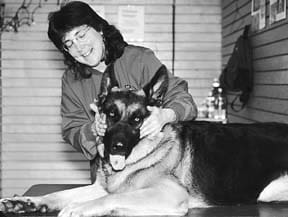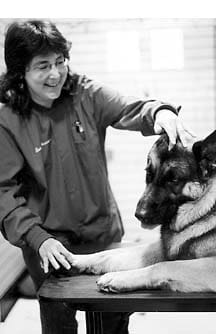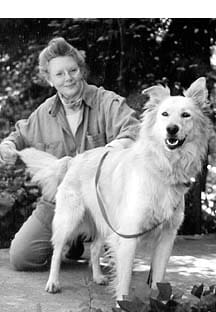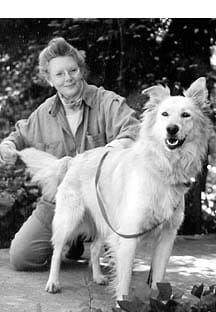[Updated June 6, 2016]
Who doesn’t love petting a dog? The soft fur, the warm body and the animal’s reciprocal affection makes stroking a dog a great pleasure for people.
Petting is also good for dogs! Just as human infants can fail to thrive when deprived of affectionate contact, puppies who receive little or no contact from their handlers fail to develop as well physically or mentally as puppies who are petted and handled often. And even if their physical needs for warmth or food are provided, mature dogs can have a difficult time bonding with or responding to their human caretakers unless they receive consistent, affectionate physical contact.
But in the last 20 years, dog handlers have learned that intentional, directed touch can offer dogs even greater physical and psychological benefits than simple petting and affection. For the most part, the variety of “dog massage” methods that are taught to dog owners and practiced by professionals follow the patterns of human therapeutic touch and movement therapy: massage, acupressure, and Feldenkrais. (The latter has been adapted and expanded for use in dogs and other animals principally by Linda Tellington-Jones, creator of TTouch.)

Knowledgeable and skilled application of one or more specific healing touches have been proven to help relieve pain and diminish stress in the dog, increasing his athletic potential, overall comfort, and even, later in life, preserving his mobility and vitality.
These healing touches also give dog owners new ways to communicate with their beloved companions, improving their relationship and understanding.
While each type of touch has been demonstrated to be helpful in certain situations, each is intended to affect a different system in the dog, so, depending on your dog’s health challenge, one may be more helpful than the others. Confusing matters is a certain amount of crossover between the schools, as practitioners mix up the techniques they find helpful to their clients.
The following is a guide to therapeutic touch methods, as well as a description of the dogs who can benefit from each.
Doggy Massages: Rubbing it in
Massage is the oldest and perhaps the most instinctive touch therapy available to dog caretakers. It’s also the easiest to explain, since the effects of massage are easy to see and document.

Massage is the use of hands (usually) to rub and knead muscle tissue with several beneficial effects. To understand how massage benefits an animal (humans included), it’s important to know that muscles only “work” in one direction; they act by “contracting,” a movement that shortens the muscle, pulling the attached parts of the body in the direction of the pull. An opposing set of muscles and/or the force of gravity returns the body part in question back to its original position. Vigorous or prolonged exercise causes many repeated contractions of the muscle fibers, “pumping” them full of blood and fluids and making it difficult for the fibers to slacken and lengthen into a resting state. Massage literally loosens and unknots the contracted, tense fibers, causing considerable relief from chronically tight or spasmed muscles. It also helps restore circulation to and in the muscles tissues, helping “unclog” the circulatory system, flushing out the waste products (lactic acid) of muscle activity and bringing in healing nutrients.
Depending on the purpose of the massage and the results the therapist wants to achieve, massage therapists employ a wide range of techniques, manipulating the muscles in a variety of ways – among them, stroking, lifting, pulling, and rolling the tissue beneath their fingers.
The benefits of massage can extend beyond the realm of the physical body. Dogs who become accustomed to massage are often easier to groom or examine. And an owner or masseuse who massages a dog regularly will be more alert to immediate problems, such as the presence of fleas, ticks or cuts. She’ll also be more likely to detect more serious developments, such as chronically sore, knotted muscles or lumps beneath the skin that could indicate the presence of cancer. By palpating the muscle tissue, experienced practitioners can easily detect areas on the dog’s body that are in need of special attention, areas which may be lumpy, stringy, or chronically tense, instead of relaxed and pliable.
Find the Right Massage Therapist for Your Dog
Of the three hands-on therapies discussed here, massage is the most easily learned, by those who want to offer their services professionally as well as those who just want to learn to massage their own dogs. One could argue that this means it is the most accessible as a career to people who lack the education or experience to offer proficient and maximally therapeutic massage. Indeed, there are no certification programs or licensing organizations for canine massage therapists, even though, curiously enough, several exist for equine massage therapists and dozens exist to train people for human massage. To massage humans, or to teach others how to massage humans, a person must be credentialed and licensed; the training involves hundreds of hours of practice and study into human anatomy and physiology. But there is nothing equivalent required to massage dogs or teach dog massage professionally.

If you are considering having a canine massage therapist work on your dog or teach you how to do so, there are things you can look for:
• Formal training and education. The best therapists know anatomy and physiology and have knowledge of as many massage techniques as possible, even if they use one type of massage predominantly. Ask the candidate about the courses they have taken, and how many hours of training were involved in those courses. The number should be well in the hundreds of hours. The therapist should also be able to answer questions regarding ideal treatments for a dog with specific health problems.
• References. The therapist should be able to give you the names and numbers of several satisfied customers. Long-term clients are better; references from veterinarians who have observed improvements in dogs whose cases they have collaborated on would be ideal.
• Ask to observe the therapist working on another client’s dog, and see how he gets along with the animal. Is the dog relaxed and happy about the experience, or anxious, tense, and trying to escape? The pressure that the therapist uses should not appear to make the dog uncomfortable.
Some of the best canine candidates for massage include dogs that put on a lot of miles every day, such as guide dogs, hunting dogs, and stock dogs, as well as “weekend warriors,” dog who lie around at home during the week while you’re at the office, and then go hiking, running or swimming with you on weekends. Older dogs with circulatory problems or degenerative arthritis (not rheumatoid arthritis) can also benefit from the soothing effects of massage.
Some therapists swear that regular massage on dogs that are prone to certain arthritic conditions, such as hip dysplasia, can help prevent those diseases. However, there are times when an owner shouldn’t massage her dog; determining these should be a matter of common sense. A dog that is so touch-shy that a massage provokes an aggressive reaction shouldn’t undergo such treatment until he’s been examined by a veterinarian for an underlying health problem. Dogs with injuries involving broken bones or broken skin, and dogs that are ill should not be massaged. Massage is not generally recommended for dogs with cancer, since the growth of some cancers can be aided by the increase in circulation that massage can bring.
Acupressure: A Timeless Art
Many massage therapists integrate varying amounts of acupressure into their massages, and, properly executed, acupressure can help relax muscles and increase blood flow. However, acupressure is not directed at the dog’s muscle tissue as it is with massage. Rather, the practitioner’s finger pressure is aimed at a theoretical body system that can’t be seen. Acupressure is a tactile variant on the ancient Chinese medical practice of acupuncture, which seeks to influence the body’s energy flow. A brief discussion of traditional Chinese medicine (TCM) is necessary to understand this modality:
The central principle of TCM is that each human being and animal is filled with a life-sustaining energy called chi (pronounced chee). The chi flows through the body via pathways, called meridians, not unlike water flows through a stream. Each meridian in the body, it is believed, influences the health of a different system in the body. When the chi is flowing smoothly and harmoniously, the body is healthy. Illness, practitioners of TCM believe, stems from disruption in the flow of the chi, whether due to a deficiency or excess in a certain area. The regular, healthy flow of energy can be restored by stimulating certain points on the involved meridians.
Traditionally, the points are stimulated by needles (acupuncture), finger pressure (acupressure), or heat (moxibustion), though modern practitioners sometimes use lasers or needles that are electrified with a tiny current. To determine where and how to stimulate the flow of chi, an experienced acu-therapy practitioner would question the dog’s caretaker about any unusual symptoms the dog may be displaying. She would want to know about the dog’s usual demeanor and health routines, in an effort to ascertain what body systems and meridians may be in need of stimulation. Finally, she would conduct a physical examination, checking the entire body for signs of diminished or excessive energy or blood flow (as indicated by cold or too-warm areas on the body).
To the dismay of those who think the TCM theory behind this therapy is hogwash, acu-therapies have been shown to increase circulation, and to release endorphins (internally produced pain killers) as well as natural cortisone and other anti-inflammatory substances. Some researchers, unable to refute these substantiated results, have speculated that there is another mechanism that is responsible for the release of these natural and beneficial chemicals. The most prevalent of these explanations is that the acu-therapies alter the bioelectricity flowing along the nerves, triggering the release of neurotransmitters that, in turn, release the endorphins and cortisone chemicals. But some proponents say the theory doesn’t matter – it works!
Acupressure can be especially useful for dogs with chronic, painful conditions including arthritis, spinal problems, and hip dysplasia. It has also been used to improve neurological conditions, lameness, balance problems, allergies (including those resulting in skin dermatitis), epilepsy, and digestive disturbances.
Proponents believe that acu-therapies, including acupressure, can be used to improve or assist in the recovery from almost any medical condition. However, some practitioners caution against using acupressure if the dog is pregnant or has recently been bred, has been fed within the past three to four hours, is fatigued from exercise, or seriously ill with cancer, an infectious disease, or a high fever.
Who Can Apply Acupressure?
According to most states’ veterinary medical practice acts, anyone who uses a needle on an animal must be a licensed veterinarian. Legally, any veterinarian could perform acupuncture, whether or not they had any formal training in the art. Straddling the two worlds is the International Veterinary Acupuncture Society (IVAS), which offers training and certification in acupuncture to veterinarians and veterinarians only. In order to become certified, veterinarians must take a 100-hour course, pass a four-hour written exam and a practical exam, and complete a 40-hour internship. This sounds good, but experienced TCM practitioners might argue that it takes hundreds of hours of study to become accomplished in “moving the chi.”
While acupressure can be legally performed by anyone, only someone with advanced training in TCM and the acupuncture meridians will be able to offer valuable work or instruction in this art.
The stimulation of acupressure is thought to be somewhat less direct and therefore less powerful than acupuncture, but it does has the benefit of being much more accessible to lay people than acupuncture. Any interested dog owner or therapist can be taught how to stimulate the appropriate acupressure meridians and points to improve certain health problems. Furthermore, no possible harm can arise from the gentle touch of acupressure, even if it is incorrectly applied.
However, a massage practitioner who says he also uses acupressure should be able to impart some information about which of your dog’s meridians or points he would choose to work on and why. If he is not intimately familiar with TCM theory or knowledge of the meridians, his “acupressure” is probably just a glorified massage – not bad, by any means, but not true acupressure.
T-Touch Magic
Massage and acupressure have been used on humans for centuries and have become popularized as therapies for animals in the last 20 years or so. But another important touch-based therapy, called TTouch, has emerged and been developed in just the last 20 years.
TTouch has its roots in another modern therapy developed by Israeli physicist and judo expert Moshe Feldenkrais (1904-1984). Following a serious injury, Feldenkrais took his rehabilitation into his own hands, studying physiology and movement therapies, and eventually formalizing his discoveries into a therapy he called Awareness through Movement, but which has more commonly become known as the Feldenkrais method.
Feldenkrais thought about the fact that the neural impulses that govern movement tend to follow the most-worn neural pathways, making most movement habitual and similar. This is the reason why people habitually walk with a certain rhythm and movement pattern, for instance, or sit with a distinctive posture. Through study and experimentation, Feldenkrais discovered that the body could be taught to use and develop alternatives to the most commonly used pathways, resulting in new movements that offered broader range of motion, for instance, or greater strength or efficiency. He distilled his observations into exercises he taught to others. Some of the exercises are undertaken by the subject alone, but in others, the subject remains relaxed while a Feldenkrais practitioner moves her body or limbs in a defined series of movements.
One of Feldenkrais’ students, Linda Tellington-Jones, absorbed Feldenkrais’ theories like a sponge, and brought them to bear on another world where she had extensive experience. An experienced horsewoman, Tellington-Jones began adapting Feldenkrais’ exercises for horses and other animals with great success, ultimately founding an internationally-recognized school of therapy based on her work.
Tellington-Jones’ initial area of focus was with horses, and accordingly, her program was dubbed Tellington-Jones Equine Awareness Method, or TTEAM. As Tellington-Jones developed her theories and exercises, she drew from other schools of healing therapies, eventually incorporating some aspects of acupressure, massage, and training into her healing modality, which became known as TTouch (pronounced Tee-touch). She also expanded her research to include work on all types of animals.
Like Feldenkrais, Tellington-Jones’ first work focused on movement. She found that horses with chronic gait irregularities, for instance, could be guided through a series of exercises that would somehow “reset” their brains and nervous systems, enabling them to move with a new and improved gait.
But soon, Tellington-Jones discovered that these exercises could have a profound impact on the way animals behaved toward their handlers. Often, an animal who entered a session resistant, angry, or defiant became compliant, relaxed, and friendly by the session’s end. Tellington-Jones theorized that because of the exercises “the body’s stored bad habits and responses to tension, pain, and fear are broken,” in other words, that the bad behaviors were a result of the animal’s pain and anxiety. When the animal was enabled to move in a new way, it was able to think in a new way, too.
TTouch practitioners explain that TTouch is directed at affecting the nervous system, which influences the mind and the body, helping the two systems to work together more efficiently and effectively. The nervous system sends messages back and forth from the brain to the muscles, so, by using TTouch to bring the brain (and the body’s) attention to little-used or previously damaged portions of the body, you re-establish communication with and use of the entire body and mind.
Because every cell in the body touches other cells in turn, Tellington-Jones says that “awakening” any cell in the body helps awaken the entire body, rather like turning on a series of lights. In fact, many people who have used TTouch on their dogs report that both emotional and physical problems tend to improve with the work.
While TTouch has been shown to improve animals’ mobility and movement, its ability to quickly extinguish behavioral problems has become its hallmark. Dogs who exhibit problem behaviors like excessive barking, fearfulness, resistance to touch, and chewing show rapid improvement with TTouch. But the therapy is at its best when addressing physical and emotional issues, such as recovering from past injuries or traumas which have sparked new, undesirable behavior like fear biting, cowering from strangers, or panicking at thunder.
Certified TTouch Practitioners
Because she invented this school of therapy, Tellington-Jones gets to determine how others can become “certified” TTouch Practitioners. Critics of the therapy object to the exclusivity of the process, citing the fact that only people who pay Tellington-Jones’ organization for the required extensive courses can advertise their services in the therapy without attracting the attention of the TTouch attorneys. To be fair, this exclusive training process does guarantee that all the practitioners who perform and teach this therapy are consistently and reliably trained and grounded in the same theory and techniques – a statement that can’t be made about massage or acupressure therapists.
Also unlike the other hands-on therapists, TTouch practitioners work on animals, and teach interested individuals how to use the therapy. While practitioners are happy to work with individual animals to get them through a health and/or behavior crisis, their goal is to teach the animal’s owner how to support and carry on that work, through private consultation or in group settings.
None of the three healing touches described above is intended to be a substitute for professional veterinary care and/or dog training. However, each of these tactile therapies can be used to supplement other treatments for canine ills. Armed with this understanding, an owner can use any or all of these techniques to enhance her dog’s quality of life and deepen the special bond between them.
Susan McCullough is a freelance writer from Vienna, VA. This is her first article for WDJ.






